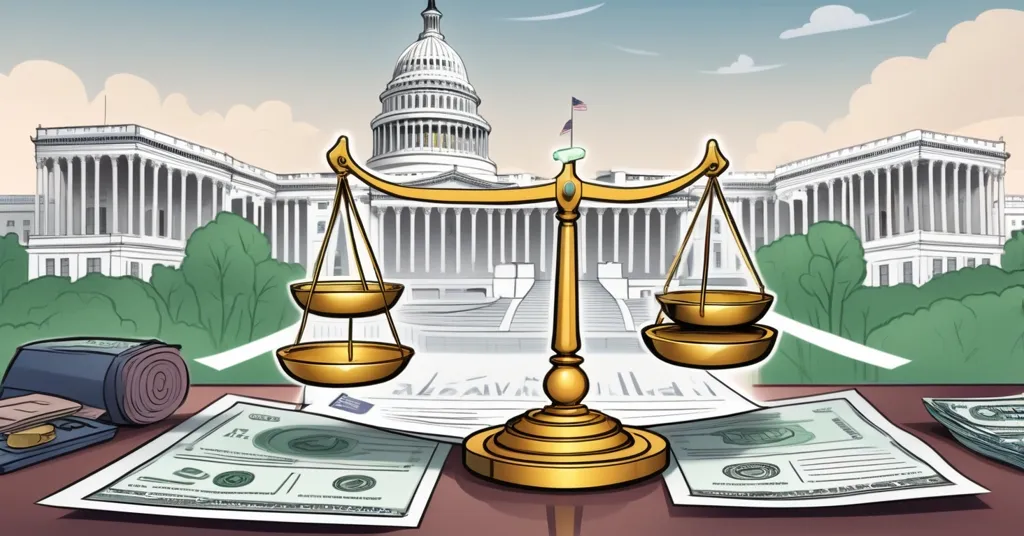U.S. Congress Pushes Stablecoin Regulation Forward with STABLE Act

U.S. Congress Advances Stablecoin Regulation with the Introduction of the STABLE Act
The U.S. Congress is making significant strides in regulating stablecoins with the introduction of the STABLE Act, a move that could redefine the role of these digital assets in the financial ecosystem. Stablecoins, cryptocurrencies designed to minimize volatility by being pegged to stable assets like the U.S. dollar or gold, are at the heart of this legislative effort. Proposed by Representatives Bryan Steil and French Hill, the STABLE Act aims to enhance transparency and consumer protection in the issuance of these tokens.
- STABLE Act introduced on March 26, 2025
- Proposed by Representatives Bryan Steil and French Hill
- Enhances transparency and consumer protection
- Bipartisan support, under Senate review
The STABLE Act, introduced on March 26, 2025, has already been approved by a key group of lawmakers in the House of Representatives and is now under review on the Senate floor. This legislative push reflects a growing recognition of stablecoins as more than just experimental assets, but as critical components of the financial infrastructure. The bill has garnered support from both Democrats and Republicans, a testament to its perceived importance in regulating this burgeoning sector.
Representative French Hill emphasized the bill’s significance, stating,
“The bill helps clarify financial rules and protects both consumers and the financial system.”
This sentiment is echoed by the bill’s co-introducer, Representative Bryan Steil, who sees the STABLE Act as a necessary step towards integrating stablecoins into the mainstream financial ecosystem.
Moving forward, another legislative proposal, the GENIUS Act, offers a different approach. Advanced by the U.S. Senate Banking Committee, the GENIUS Act specifically targets payment stablecoins and proposes a dual oversight model involving both federal and state regulators. This approach aims to balance innovation with consumer protection, ensuring that stablecoins can thrive under a clear regulatory framework.
The legislative process is not without its challenges. Representative Tom Emmer noted,
“Although the House and Senate bills differ in some areas, lawmakers expect to reconcile those versions as the process moves ahead.”
This reconciliation will be crucial in determining the final shape of stablecoin regulation in the U.S.
In a move to strengthen the STABLE Act‘s foundation, the House Subcommittee on Digital Assets, Financial Technology, and Artificial Intelligence held a hearing titled “A Golden Age of Digital Assets: Charting a Path Forward.” This hearing underscores the urgency of establishing a robust regulatory framework for stablecoins.
President Donald Trump has also weighed in on the matter, encouraging lawmakers to pass stablecoin legislation before the August 2025 recess. His involvement highlights the political significance of this issue and the potential impact on the broader cryptocurrency market.
Amidst these regulatory efforts, the debate over the type of stablecoins to prioritize has gained traction. Max Keiser, a prominent Bitcoin advocate, argues that gold-backed stablecoins could gain dominance globally, particularly in countries with strained ties to the U.S. He points to Tether’s Alloy (aUSD₮), launched in June 2024, as a prime example of this trend. Keiser stated,
“Countries with strained ties to the U.S. often view gold as more stable than the dollar.”
This perspective adds a layer of complexity to the regulatory debate, as lawmakers must consider the geopolitical implications of their decisions.
The introduction of the STABLE Act and the GENIUS Act signals a shift in how stablecoins are perceived—from experimental assets to critical financial infrastructure. This shift could have far-reaching implications for the cryptocurrency market, potentially increasing transparency, consumer trust, and global investor confidence in digital assets.
As the legislative process unfolds, it’s clear that the U.S. is at a pivotal moment in shaping the future of stablecoins. The outcome of these efforts will not only impact the domestic market but also set a precedent for global regulatory standards in the cryptocurrency space.
While these regulations focus on stablecoins, they could set a precedent for how Bitcoin and other cryptocurrencies are treated in the future. Bitcoin maximalists might argue that these regulations could either hinder or help the broader adoption of cryptocurrencies, depending on how they are implemented.
Key Takeaways and Questions
- What is the STABLE Act and who introduced it?
The STABLE Act is a legislative proposal aimed at regulating stablecoins, focusing on transparency and consumer protection. It was introduced by U.S. Representatives Bryan Steil and French Hill.
- How does the STABLE Act differ from the GENIUS Act?
The STABLE Act outlines broad federal rules for stablecoin issuers, while the GENIUS Act focuses on payment stablecoins and proposes a dual oversight model between federal and state regulators.
- What is the current status of the STABLE Act in Congress?
The STABLE Act has passed through the House Banking Committee and is currently under review on the Senate floor.
- What role do gold-backed stablecoins play in the regulatory debate?
Gold-backed stablecoins, such as Tether’s Alloy, are seen as potentially gaining traction globally, especially in countries with less trust in the U.S. dollar, adding complexity to the regulatory debate.
- How might these regulatory efforts impact the broader cryptocurrency market?
These efforts signal a shift from viewing stablecoins as experimental to treating them as critical financial infrastructure, potentially increasing transparency, consumer trust, and global investor confidence in digital assets.



